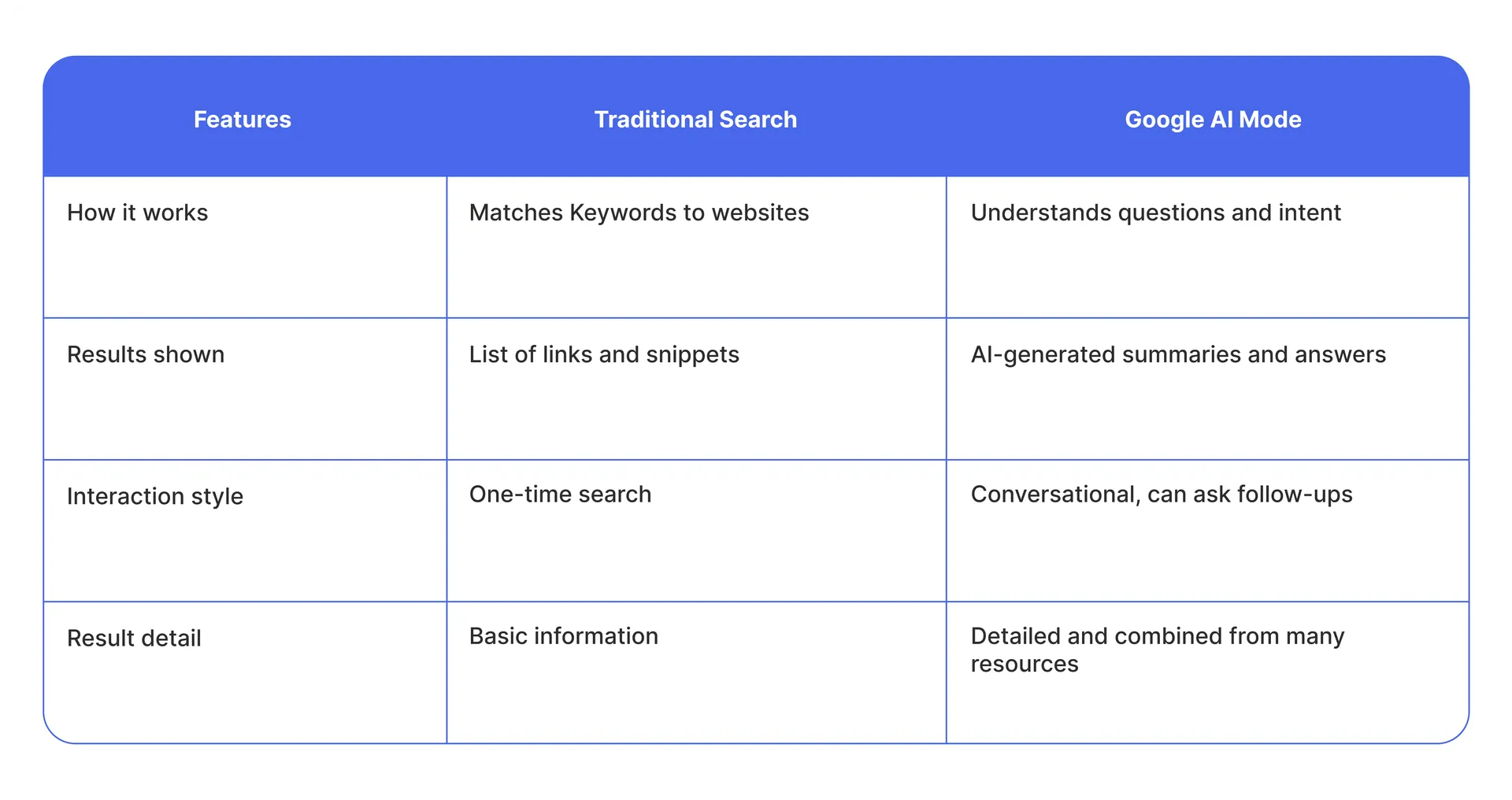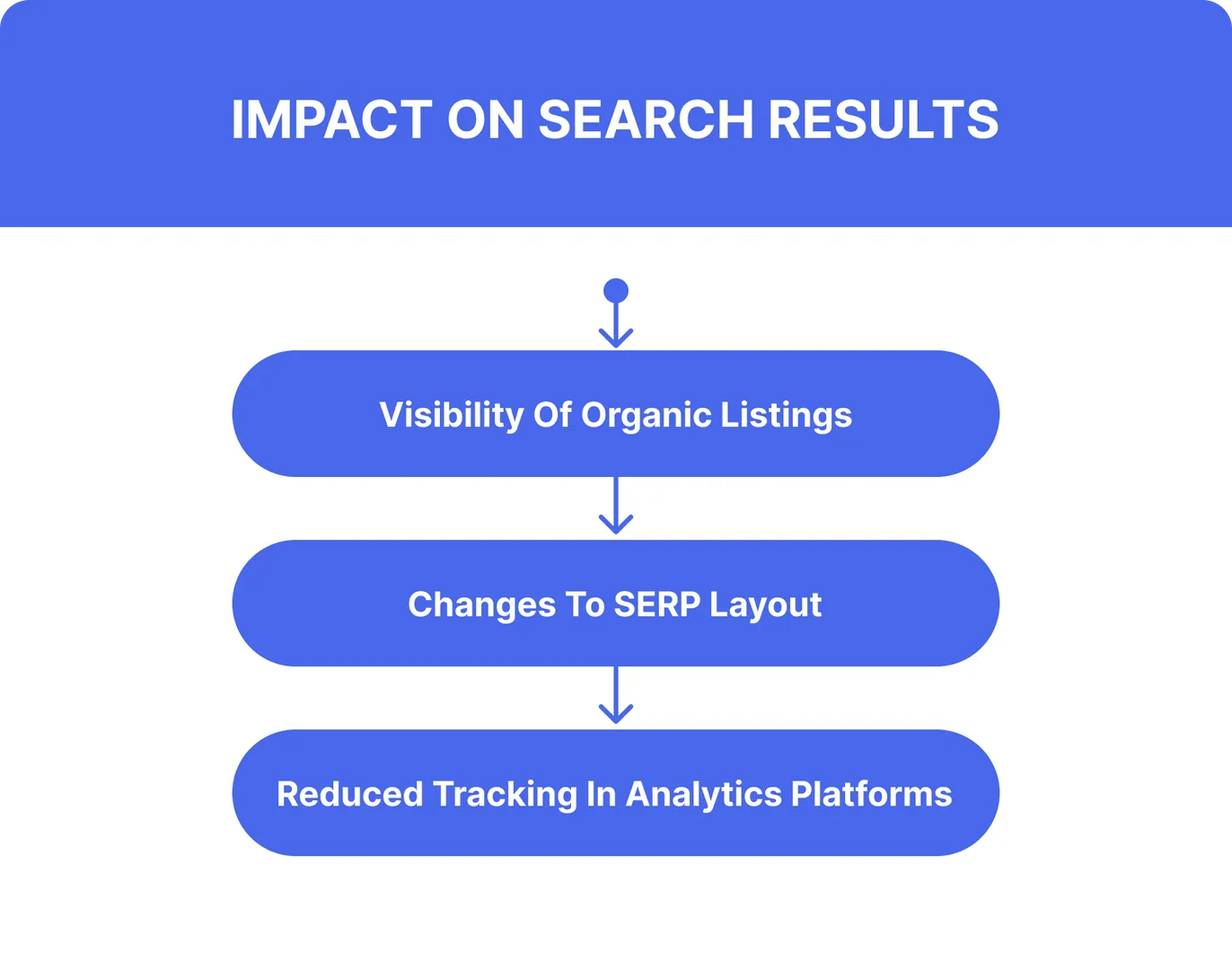Google AI Mode: How It's Changing Search & SEO in 2025
Learn how Google AI Mode is transforming SEO in 2025. Get proven strategies to adapt to AI-powered search and maintain website visibility.

Summary:
Google AI Mode is reshaping the way we search and how websites get found. Launched on May 20, 2025, this major update has rolled out to U.S. users, bringing a dramatic shift in how Google delivers results. With 2 billion monthly users and 86% of searches now showing AI-generated content, this change affects every website's visibility. With AI deeply integrated into Google Search, everything from search rankings to content visibility is evolving fast. This isn’t just another algorithm update; it’s a fundamental shift in how users receive information.
For SEOs, marketers, and content creators, understanding Google AI Mode and tools like the Search Generative Experience (SGE) is no longer optional. In this blog, we’ll break down what’s changing, why it matters, and how to future-proof your SEO strategy in an AI-driven search landscape.
What is Google AI Mode?
Google AI Mode is Google's new AI-powered search experience that uses artificial intelligence to deliver instant, comprehensive answers. Instead of showing just a list of links, it reads information from multiple websites and creates a clear, summarized answer, helping you find what you need without clicking through multiple pages.
This new search style is called the Search Generative Experience (SGE). It means Google’s AI can read information from different websites and give you a short, helpful summary, so you don’t have to check every site yourself.
Key Differences Between Google AI Mode and Traditional Search

Google AI Mode changes the way we search by making it smarter and more helpful. It’s designed to give you the right answer quickly, without making you click through lots of websites.
Key Features of Google AI Mode
Google AI Mode has several powerful features that make searching easier, faster, and more useful. Here's what makes Google AI Mode different from regular search:

1. AI-Generated Answers
Instead of just showing a list of websites, Google AI Mode gives you a full answer written by AI. It gathers the most important details from different sources and presents everything in one place.
2. Conversational Search
You can ask follow-up questions without starting over. The AI understands what you’re asking and keeps the conversation going, just like talking to a real person.
3. Summarized Results
The AI provides a quick summary of the top results. This saves time because you don’t have to read through every link to find what you need.
4. Context Awareness
Google AI Mode understands the meaning behind your search–not just the words you type. It looks at the full context to give more accurate and relevant results.
5. Visual and Rich Content
In some cases, you’ll see images, charts, or other visuals alongside the AI response, making the information more interactive and easier to understand.
These features make Google AI Mode a smarter way to search, helping users get better results with less effort.
How Google AI Mode Impacts Search Results
Google AI Mode is changing the way search results appear and how users interact with them. While it helps users find answers faster, it also brings some major changes for website owners, SEO professionals, and digital marketers. Here’s how it affects search results:

1. Lower Organic Visibility
AI-generated answers appear at the top, pushing traditional results down by 1,630 pixels on average. Research shows click-through rates drop 34-46% when AI summaries appear. Even if you rank #1, fewer users will see or click your link.
2. Changes to SERP Layout
The search engine results page (SERP) looks different from Google AI Mode. The AI answer box takes up more space and appears before ads and organic links. Sometimes, rich media like images or product cards are also included, which can affect how much attention other links receive.
3. Reduced Tracking in Analytics Platforms
Because users may not click through to websites as often, tools like Google Analytics might show less traffic from searches. This can make it harder for website owners to measure how well their content is performing, even if it’s being used in AI summaries.
These changes mean businesses and marketers need to adjust their SEO strategies to stay visible and relevant in this new AI-powered search environment.
SEO Challenges in the Era of AI Search
As AI becomes a bigger part of how Google delivers search results, SEO experts and content creators are facing new challenges. While AI-powered search can improve user experience, it also creates problems for websites trying to attract and measure traffic. Here are some of the main concerns:
1. Loss of Traffic Attribution
With AI summaries answering questions directly on the search page, fewer users are clicking through to websites. This makes it harder for site owners to see where their traffic is coming from or how their content is performing, even if it’s being used.
2. Content Usage Without Referral
Google AI Mode pulls information from websites to build its answers, but it doesn’t always link back clearly. This means your content might be used in search results without driving any visits to your site, reducing the value of creating high-quality content.
3. Publisher and Expert Concerns
Many publishers, bloggers, and industry experts are worried that their work is being shown in AI answers without credit or traffic. This raises questions about content ownership, fair use, and how creators will be rewarded in the future.
In this new era of AI-driven search, SEO isn’t just about ranking anymore, it’s about making sure your content stays visible, credited, and valuable.
Adapting Your SEO Strategy for AI Mode
As Google’s search evolves with AI integration, traditional SEO approaches must also transform. Below are the essential strategies to help you adapt your SEO for AI-powered search success.
1. Optimize for AI Understanding
Write content that AI can easily read and trust:
Use clear headings and short paragraphs
Answer questions directly and completely
Add statistics, examples, and expert quotes
Structure content with bullet points and tables
Update regularly to stay current
2. Build Trust Signals (E-E-A-T)
Show Google's AI that you're credible:
Add author bios with credentials
Include first-hand experience and real examples
Cite reliable sources and data
Use schema markup for better AI understanding
Get backlinks from authoritative sites
3. Target Conversational Queries
Optimize for how people actually search with AI:
Use natural, conversational language
Target longer questions like "How does Google AI Mode affect my SEO?"
Answer follow-up questions in the same article
Focus on user intent, not just keywords
4. Track New Success Metrics
Traditional metrics like rankings matter less. Focus on:
Time on page and scroll depth
Brand mentions in AI responses
Direct traffic and branded searches
Engagement and return visitors
Pro Tip: Set up Google Alerts to track when AI mentions your brand.
Publisher Concerns and Implications
As AI-driven search features become more prominent, many publishers are raising important concerns about how their content is being used–and what it means for the future of digital publishing.
Content usage without proper visibility
With the rise of Google’s AI-powered search, publishers are finding that their content is being used to generate answers without driving traffic back to their websites. This means users get the information directly in the AI summary and never visit the source, reducing visibility, clicks, and potential revenue for original creators.Limited options for publishers to block their content
Unlike traditional search indexing, where publishers had more control, current AI features offer very limited options for publishers to block their content. Even if publishers don’t agree, their content can still be used in AI-generated responses, leaving them without a clear way to protect their work or manage how it appears in search results.Expert opinions from industry leaders
Many experts and media professionals are worried about the long-term effects. They believe this change could hurt content ownership and long-term success, especially for smaller publishers and independent creators. Industry leaders are asking for clearer rules, fair payment, and responsible use of AI-generated content.
The Future of SEO with Google AI Mode
What's Coming:
AI will continue expanding to more countries and languages
Quality content will matter more than ever
Thin, keyword-stuffed content will become invisible
Brand authority will be more valuable than traffic
How to Stay Ahead:
This Month:
Add E-E-A-T signals to your top content
Implement schema markup on key pages
Start creating longer, comprehensive articles
Next 3 Months:
Build topic clusters on your expertise areas
Focus on conversational, question-based content
Track AI citations of your brand
Long-Term:
Diversify beyond Google (email, social, direct)
Build brand authority and thought leadership
Create content worthy of AI recommendations
Conclusion
Google AI Mode is transforming search with 2 billion users and growing. Traditional SEO tactics like keyword stuffing won't work anymore. AI favors clear, authoritative, and helpful content.
Your Action Plan:
Audit your content for trust signals (author bios, sources, expertise)
Add schema markup to help AI understand your pages
Create comprehensive content that answers complete questions
Track brand mentions, not just rankings
The shift is already here. Adapt now by focusing on quality, expertise, and content that AI systems want to cite, not just rank.